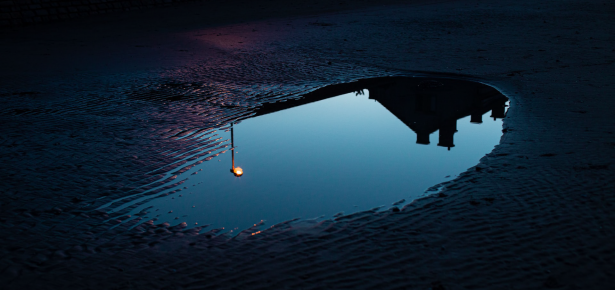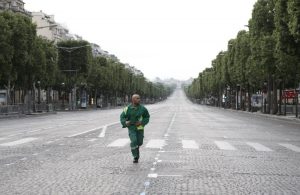
For years Hollywood has been filming the viral apocalypse, and now at last we seem to be trapped in it—though our virus is not as fast-acting or as deadly as those on film. Nor is it as interesting in its effects. We are not yet biting each other or falling into fits of uncontrollable rage or turning into zombies. At least not yet. Though at times, in Michigan or Ohio, it almost seems that the rage has come upon us.
Lorrie Moore says that we are now in the “Zombie Apocalypse” her students have been writing about. “Is a virus not a kind of zombie,” she asks, “a quasi- life-form moving in and out of inertness? . . . [Since] the virus can’t be transmitted when all its hosts have died, we are all social-distancing; that is, pretending to have died, lying very still, so the virus . . . won’t get us” (The New Yorker, 4-13-20).

The requirement of sheltering in place has created another feature of apocalyptic films: the empty city. Thom Eberhardt’s Night of the Comet was in fact intended as a comic horror tribute to “the Empty City
film” that he considered a subset of the apocalyptic genre. As did, possibly, E. E. Isherwood in his novel Empty Cities, where “there are no more red or blue states; just empty states. And empty cities.

Of all the films in which a pathogen is a global threat, the one that comes closest to where we are now is Contagion (2011), whose makers drew on the wisdom of experts, including epidemiologists at the WHO and CDC. The virus in this film (MEV-1) originated like Covid-19 in China, where an infected bat dropped a banana that was eaten by a pig. And though MEV-1 is more virulent than Covid-19, it, too, presents as a respiratory disease, transmitted by coughing or sneezing tiny droplets suspended in the air or falling on surfaces. The film’s prescience extends to the con artist Alan Krumwiede (Jude Law), who promotes deep-state paranoia even as he makes millions touting a “cure” (tincture of forsythia) for which there is no supporting scientific evidence.

But we’re not in a movie or narrative of any kind, never have been, and that’s the important point. Narratives are artifacts. They are made from what happens, real or imagined. Time runs faster in them and it comes to an end, taking its characters with it. So, narratologists (a real word) like to speak of what happens in our lives not as narratives but as more or less narratable. It’s all the stuff that’s happening out of which narratives can be spun. And for sure there is hugely narratable material on the front lines of this pandemic: doctors and nurses risking their lives to save ours. While overhead, political battles surge, out of which, surely, dark comedies will be spun. And most likely, in some of our locked-down abodes, there is material for intense, spatially compressed dramas along the order of O’Neil (Long Day’s Journey into Night) or Pinter (The Birthday Party), which is no doubt why the divorce rate goes up when lock-downs end.
But for many, perhaps most, of us the coronavirus has cut the narratable threads of our lives and left us collectively floating in unnarratable time. This is new for us, feeling the texture of time as it creeps along, wondering when the curtain will finally come up and we are set free to begin doing all those things out of which stories can be made.
Latest Comments
Have your say!